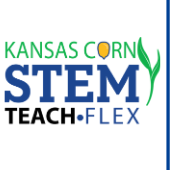Breakout Box,Explore Corn,TEACH-FLEX
Kernel Kode
Grade Levels: Middle School,High School
Corn is a vital part of the Kansas economy and landscape. As cities grow, many people move away from an understanding of agriculture, even though it is essential to their lives. This breakout box activity is designed to provide students basic knowledge of corn and the many benefits that it provides to us. Students will also be introduced to the various stages of corn growth and where corn is primarily grown. This activity complements the Seed to STEM labs Explore Corn and Growing Degree Days. It can be used as an introductory lesson to one or both of those labs, or can be altered to serve as more of an assessment following the completion of the Explore Corn and Growing Degree Days labs.

TEACH-FLEX Option: Online Breakout Box
Using breakout.edu, our game can be played online. No physical box needed! Teacher Tip: Instructions below are for the classroom breakout box. For help with the answers to the online game, simply go to the Online Lock Combinations tab.
Digital Breakout Box: Kernel KodeQuick Links
About Kansas Corn STEM
Investing in Kansas teachers and students is a priority for the Kansas Corn Commission. We are committed to providing materials and training to support STEM education while fostering an understanding of how corn farming and agriculture fit into our daily lives. Professional development workshops are offered to teachers seeking to expand their knowledge and inquiry-based teaching skills.
Workshop InfoThis lesson is the work product of the Kansas Corn Commission. Our lessons are written in collaboration with Kansas teachers for use in the classroom. Teachers may copy and share this curriculum. Use of this product for commercial or promotional use is prohibited without express permission of Kansas Corn.
Newsletter Sign Up
Each quarter we release a newsletter written by teachers for teachers. This is an easy way to keep up with what is happening at Kansas Corn STEM.
Subscribe Today!
